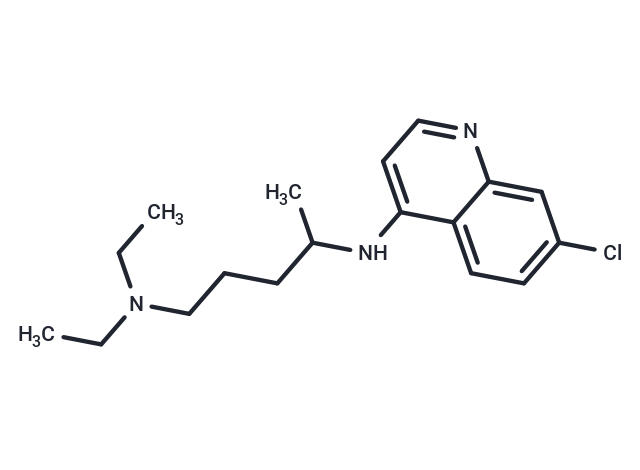Shopping Cart
- Remove All
 Your shopping cart is currently empty
Your shopping cart is currently empty

Chloroquine is a Toll-like receptor inhibitor that inhibits autophagy. Chloroquine has anti-malarial and anti-inflammatory activity and is widely used in the treatment of malaria and rheumatoid arthritis. Chloroquine also has anti-SARS-CoV-2 (COVID-19) activity and anti-HIV-1 activity.

| Pack Size | Price | Availability | Quantity |
|---|---|---|---|
| 100 mg | $54 | In Stock | |
| 200 mg | $94 | In Stock | |
| 500 mg | $189 | In Stock | |
| 1 mL x 10 mM (in DMSO) | $50 | In Stock |
| Description | Chloroquine is a Toll-like receptor inhibitor that inhibits autophagy. Chloroquine has anti-malarial and anti-inflammatory activity and is widely used in the treatment of malaria and rheumatoid arthritis. Chloroquine also has anti-SARS-CoV-2 (COVID-19) activity and anti-HIV-1 activity. |
| In vitro | METHODS: Human cholangiocarcinoma cells QBC939 were treated with Chloroquine (1.2-200 µM) for 24 h. Cell growth inhibition was detected by MTT. RESULTS: Chloroquine dose-dependently inhibited the cell growth of HRECs with an IC50 of 53.01 µM. [1] METHODS: Human non-small cell lung cancer cells A549 were treated with Chloroquine (10-80 μM) for 24 h. The expression levels of target proteins were detected by Western Blot. RESULTS: Chloroquine induced an increase in LC3-II expression and a decrease in LC3-I expression, resulting in an increase in the LC3-II/LC3-I ratio. The highest LC3-II/LC3-I ratio was observed with 40 μM Chloroquine treatment. [2] METHODS: Human osteosarcoma cells U2OS and human cervical cancer cells HeLa were treated with Chloroquine (100 μM) for 5 h. LAMP1, a marker protein for late endosomal compartment and lysosome, was detected by Immunofluorescence. RESULTS: Chloroquine increased the area of LAMP1 positive structures. [3] |
| In vivo | METHODS: To investigate the effects of Chloroquine on acute liver injury and its potential molecular mechanisms, a single dose of Chloroquine (5-50 mg/kg) was administered intraperitoneally to C57BL/6 mice 2-24 h before CCl4 (10 mL/kg) injection. RESULTS: Chloroquine pretreatment significantly inhibited CCl4-induced acute liver injury, as evidenced by a decrease in serum aminotransferases, aspartate aminotransferase, and a decrease in the histological score of liver injury, and down-regulated CCl4-induced high-mobility histone 1 (HMGB1) expression in liver tissues as well as the levels of serum HMGB1, IL-6, and TNF-α. levels. [4] METHODS: To investigate the relationship between Chloroquine and retinopathy, Chloroquine (50 mg/kg ) was administered intraperitoneally to C57/BL6 mice three times a week for six weeks. RESULTS: Chronic administration of Chloroquine induced retinopathy in mice. mRNAs for IL-1β mRNA, a component of inflammatory vesicles, and caspase1 were increased in the retinas of Chloroquine-treated mice, consistent with the initiation of inflammatory vesicles, and NTPDase1 was increased, suggesting an increase in extracellular ATP in the retina. [5] |
| Alias | CQ |
| Molecular Weight | 319.87 |
| Formula | C18H26ClN3 |
| Cas No. | 54-05-7 |
| Smiles | CCN(CC)CCCC(C)Nc1ccnc2cc(Cl)ccc12 |
| Relative Density. | 1.0500 g/cm3 (Estimated) |
| Storage | Powder: -20°C for 3 years | In solvent: -80°C for 1 year | Shipping with blue ice. | ||||||||||||||||||||
| Solubility Information | 10% DMSO+40% PEG300+5% Tween 80+45% Saline: 5.25 mg/mL (16.41 mM), suspension.In vivo: Please add the solvents sequentially, clarifying the solution as much as possible before adding the next one. Dissolve by heating and/or sonication if necessary. Working solution is recommended to be prepared and used immediately. DMSO: 45 mg/mL (140.68 mM), Sonication is recommended. H2O: <1 mg/mL (insoluble) Ethanol: 100 mg/mL (312.63 mM), Sonication is recommended. | ||||||||||||||||||||
Solution Preparation Table | |||||||||||||||||||||
DMSO/Ethanol
| |||||||||||||||||||||

Copyright © 2015-2025 TargetMol Chemicals Inc. All Rights Reserved.